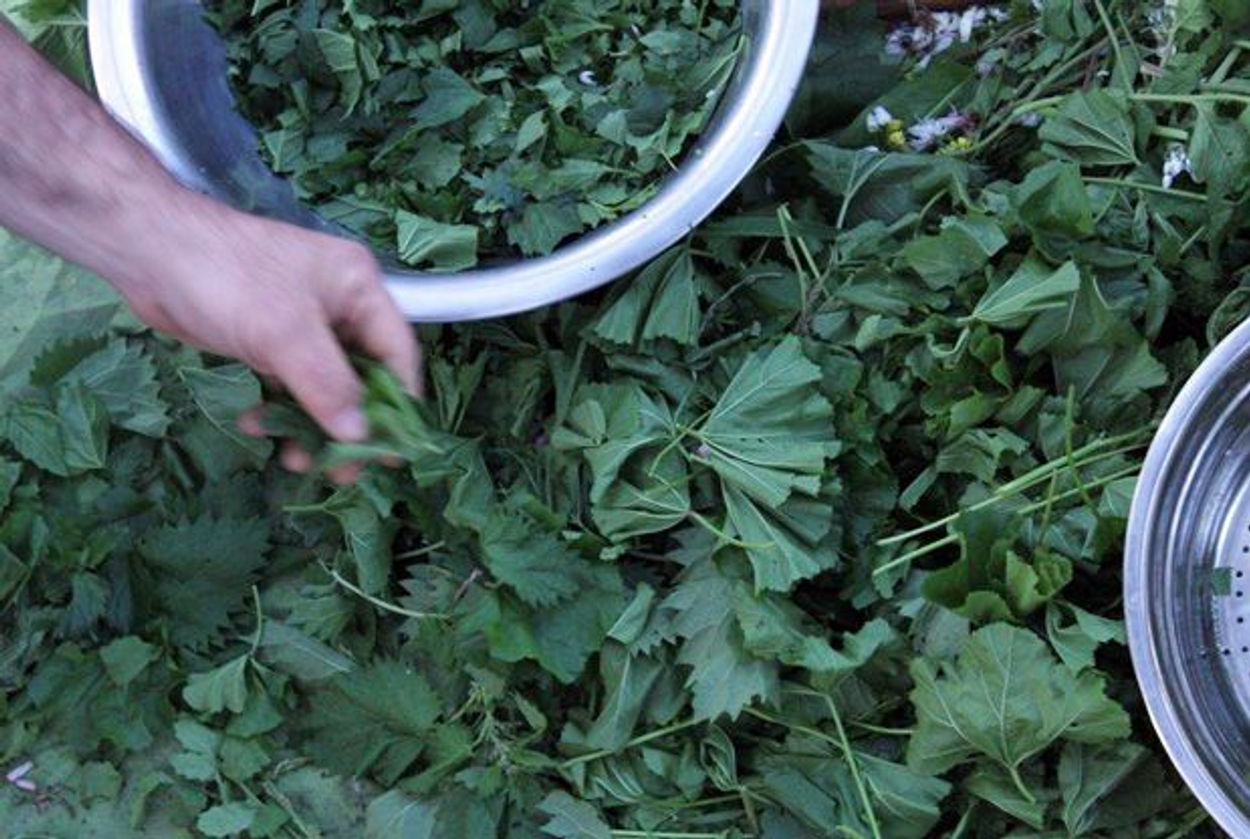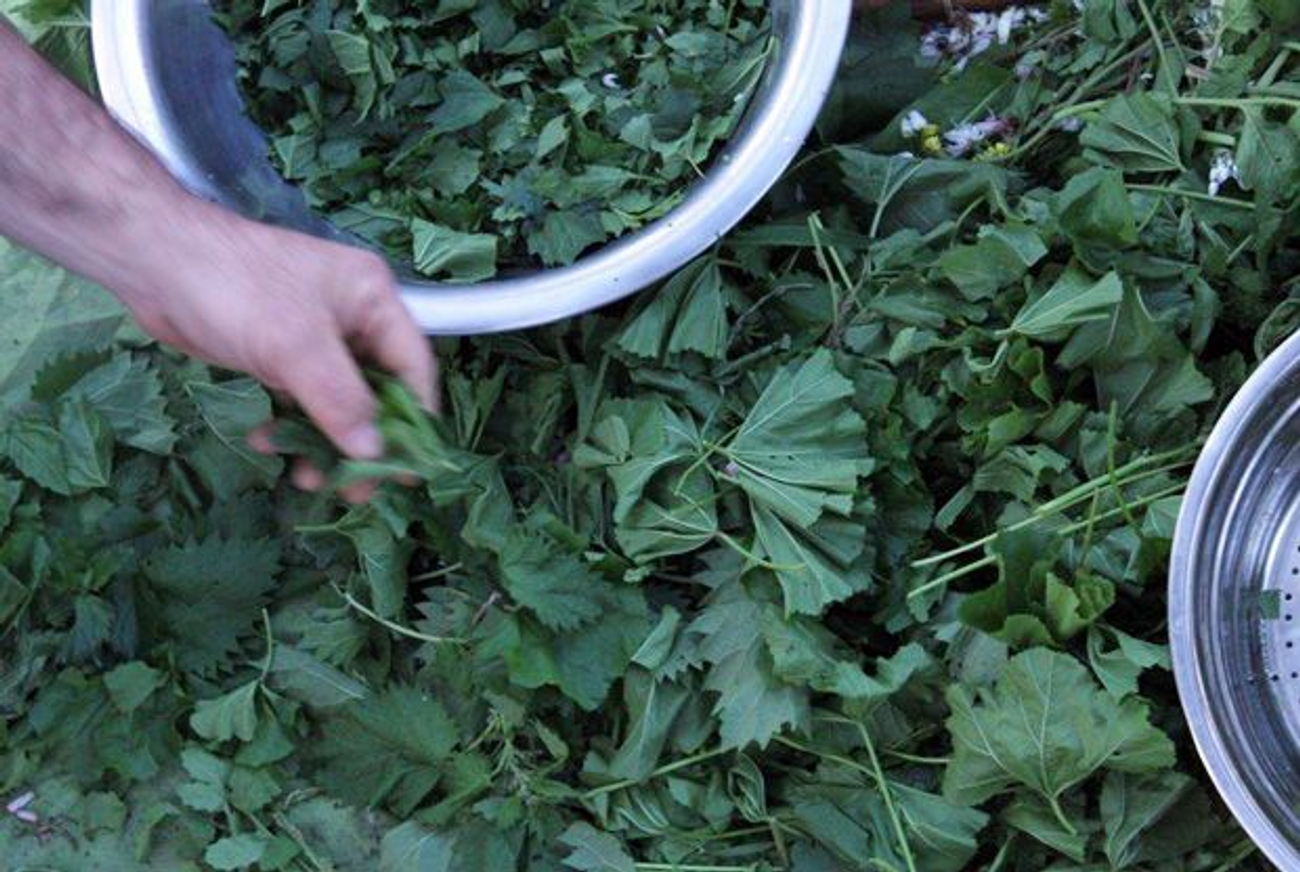Israeli Chefs Think Green
As Israeli cuisine focuses on locally grown food, cooks turn over an old leaf: mallow, a weed with biblical roots




In winter, right after the rains begin, roadsides and backyards across Israel are suddenly filled with a green weed called malva, more commonly known as mallow. But it is not just any ordinary weed. Mallow has been used in cooking since ancient times—and it is making a comeback in Israeli cuisine today.
Israeli kids are enrolling in nature-appreciation courses and taking field trips to pick mallow, which is then cooked in simple recipes like omelets, green rice, or vegetarian patties. Creative home-cooks substitute mallow for spinach in pretty much any recipe, from salads and soups to quiche and gnocchi, while health freaks add it to nutritious shakes. At the beginning of the winter, tender mallow stems and leaves can be used in salads. When the plants bloom toward the end of spring, their purple flowers can be added to salads, although the stems can’t be consumed any longer because they become fibrous; the leaves can’t be eaten raw at this point, either, but they can certainly be stewed, simmered, or cooked in various ways. The small fruit is also edible and is particularly popular among children.
“Mallow is the most important edible wild plant in the local gatherer society,” said Uri Mayer-Chissick, a doctor of local nutritional and medicinal traditions who’s been dubbed “The Israeli Locavore.” “That’s evident from its name. Both in Hebrew and in Arabic, its name is derived from the word [for] bread, which in all Semitic languages describes the most important food. Today’s mallow trend is simply going back to our roots.”
***
If the name “mallow” reminds you of marshmallows, it’s no accident: Long before marshmallows were made out of sugar, corn syrup, water, and gelatin, ancient Egyptians made them from the pith or the sap of the marshmallow plant—which, of course, is a kind of mallow.
The Egyptians weren’t the only ones using mallow. The plant was popular in ancient Rome, as well: Horace, the Roman poet, for instance, said his modest diet was made up mainly of olives, endive, and mallow. And mallow is mentioned in the Bible, which uses its Hebrew name. “In the Book of Job, the plant was called chalamut, and later, in the Mishnah, it was mentioned several times by its modern name, chalamit,” said chef Moshe Basson, owner and chef of the highly regarded Eucalyptus restaurant in Jerusalem. “The name chalamit comes from challah, because its fruit looks like a little challah.” Today, many Israelis call mallow by its Arabic name, khubeza, or refer to it as “Arabic bread,” because khubez means bread in Arabic.
During the battle for Jerusalem in 1948, when the city was under siege and food supplies were short, the people of Jerusalem started cooking with mallow; it grows everywhere, on any abandoned piece of land, no matter how small, especially in populated areas. “The idea to cook with mallow during the siege belonged to Rachel Yanait Ben-Zvi, the wife of the second President of Israel Yitzhak Ben-Zvi,” said Basson. “But they didn’t know whether or not to air mallow recipes on the radio for the benefit of other besieged Jews in Jerusalem, because they didn’t want the enemy to know how bad the situation in the city was. It was decided not to air the information on the radio.”
After that, however, Israeli Jews pretty much abandoned mallow, even though the country is full of the plant. It remained popular in Eastern Mediterranean and Arabic cuisine, and it is popular in Greece, Turkey, Syria, and Egypt, among other countries; in Israel, however, mallow was used only by Arab mothers and grandmothers.
Basson takes the credit for bringing mallow back for Israeli Jews. He has cooked with mallow for as long as he can remember: “I grew up with Arab kids, and I knew mallow and other local wild herbs from their mothers’ kitchens,” he said. “Nowadays young Arab mothers don’t cook with mallow as much as their mothers did. Sometimes it is even considered a bit embarrassing to cook with it.”
“Since I have always cooked with mallow for my friends and family, when I opened my restaurant, I wanted to make mallow part of the menu, even though it was a novel idea,” Basson added. “I had Druze friends in the army, so I went to their mothers to learn more about mallow.”
Serving a biblical and local menu at Eucalyptus, Basson incorporates mallow in various dishes, starting from what he calls “siege-style khubeza”—a warm salad made out of sauteed mallow leaves with onions, garlic, and olive oil—to khubeza soup and stuffed mallow leaves. Ninety percent of the mallow he uses grows wild. Arabic restaurants in Israel, from Jaffa to Nazareth, also cook with mallow, but Basson says it wasn’t always like that: “For many years, Arabic restaurants in Israel wouldn’t have dared serve mallow dishes,” he noted. “After I started serving mallow dishes, other restaurants—Arabic and Jewish alike—started doing it, too.”
Cooking with mallow is more popular than ever today, since Israelis have started searching for an authentic indigenous cuisine of Eretz Israel, and also because the ever-growing health-trend encourages consuming any edible green herb. “Eating mallow is extremely good for your digestive system and its maintenance,” said Mayer-Chissick. “Like any wild herb, it is important that you pick it and eat it fresh. That way its nutritional value is a thousand times higher than any plant that is store-bought and was picked a few days ago.”
Eating mallow, Mayer-Chissick said, is part of eating locally grown food: “The point is getting closer to the source of our food, and the simplest thing is to return to what anyone can do, like go out to the garden and pick some mallow,” he said. “The mallow is a local plant, therefore it is popular mainly in cuisines that are based on local produce, like the Arabic cuisine, or the kind of Jewish cuisine that is trying to reconnect with its local roots.”
***
There are many different species of mallow all over the world that differ in size, shape, and taste. Although mallow is not widely recognized or used, America has it growing wild, too. While in Israel bull-mallow is the most prevalent variety, in California Malva neglecta, or common mallow, is more widespread. It is also called buttonweed or cheeseplant, since the fruit that reminds Arabs and Israelis of bread reminds Americans of little buttons or wheels of cheese.
“Mallow is an invasive European weed in America, but it is also a well-known edible among foragers,” said Hank Shaw, a cookbook author in Sacramento, Calif., who runs the website Hunter Angler Gardener Cook. “Nevertheless, I don’t know too many people who eat mallow here—even among foragers—and it has no role in traditional American cooking. I have never seen it in any market in any form.”
Although Americans usually don’t cook with mallow, Shaw likes to use the leaves to wrap dolmas: “For dolmas, I like to use bull-mallow (Malva nicaeensis), because it has larger leaves than common mallow (Malva neglecta). I only use them as a springtime dolmades wrapper—I switch to grape leaves when they are ready. Mallow dolmas are more tender than grape-leaf dolmas, and once you blanch the leaves, that weird fuzziness they have goes away.”
***
Like this article? Sign up for our Daily Digest to get Tablet Magazine’s new content in your inbox each morning.
Dana Kessler has written for Maariv, Haaretz, Yediot Aharonot, and other Israeli publications. She is based in Tel Aviv.
Dana Kessler has written for Maariv, Haaretz, Yediot Aharonot, and other Israeli publications. She is based in Tel Aviv.